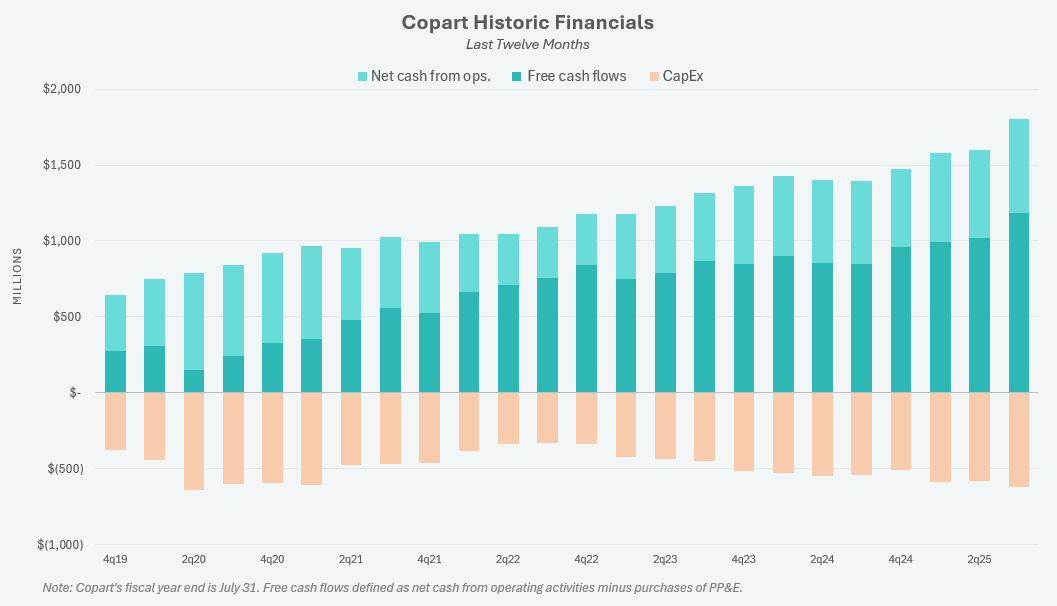“The one afterthought I'd offer is that our capitalization with our clients is a distinctive competitive advantage. Our conservative balance sheet, our net cash balance, equips us such that we can be patient even through a crisis. So in the midst of a pandemic, when nobody knew for how long driving an economic activity would be shut down, we were able to continue our business as it stands today. We didn't lay off folks. We didn't suspend CapEx, et cetera.
Our insurance clients have a long memory, and they know those things. They know that when land is available for us to acquire, so that we can preserve it for the industry's use for the next 50 years, that we'll do so gladly and proudly, despite it of course coming with big ticket prices as well.”
—Jeff Liaw, CEO of Copart, Feb. 22, 2024
Copart reported is Q3 2025 results last Thursday evening. Quarterly revenues and operating profits each made new all-time highs. The day after, the share price fell over 10%. Were investors disappointed by high single-digit revenue growth as opposed to another quarter of low double-digit growth? That operating margins declined slightly from the prior year’s 38.8% to just 37.3%? We have no idea.
As the business grows through thick and thin—hurricanes, pandemics, “Tariffs: Part Deux”—the cash on its balance sheet continues to pile up. And this is happening despite Copart regularly purchasing, rather than renting, valuable land for future auto salvage storage. It’s happening despite Copart investing in its people and equipment and despite developing and introducing new services for its clients around the world.
Regardless of whether one considers recent results a disappointment, I remain convinced the more important story is whether Copart’s capital allocation framework will evolve as a result of the constant growth of its “gil” (Final Fantasy speak for money or currency).
With cash from operations and free cash flows for the trailing twelve months making new all-time highs this most recent quarter, Copart now has nearly $4.4 billion of cash. Coupled with zero debt and $1.3 billion available from their revolving credit facility, Copart has $5.6 billion of liquidity. Compare this to its $52 billion market cap as of 5/23/25.
The Cash Pile
Since the end of 2019, Copart’s 12-month capex spend has ranged from $335 million to $640 million, the majority of which has been for growth and expansion.
With limited options to fully deploy the cash it generates, the cash pile is likely to grow by another $1.3 billion over the next twelve months. So what has management said about this subject? In short, they continue to view the cash pile as a strategic, multi-purpose asset.
First, it’s a great feature when they’re making their sales pitch to their insurance carrier partners. When compared to their main competitor IAA (now owned by RBA Global), Copart has a huge pile of cash whereas IAA is part of a larger enterprise with 3.1 turns of leverage (based on net debt of $3.84 billion to $1.22 billion of EBITDA). Which company is more likely to spend what is needed on behalf of customers? Which company can more easily endure an annus horribilis with multiple catastrophe events from hurricanes, twisters, and hail storms? Copart’s ample liquidity coupled with zero debt makes it a relatively more attractive partner to do business with.
Second, Copart does have a record of making large share repurchases when there has been large disconnections between share price and intrinsic value. Although it has been a long time since Copart’s last share repurchase (2019), and it is unlikely to happen in the near term given the elevated valuation of the company, this optionality should be quite valuable to shareholders if the share price declines to a more attractive price.
A Berkshire-Like Affinity for Liquidity
For decades, Warren Buffett and Charlie Munger maintained ample liquidity in Berkshire Hathaway’s insurance operations to: (1) assure their own survival in a year of multiple catastrophes and (2) to take advantage of dislocations due to these catastrophic events. By acting in such a unique way, the insurance industry received a nice benefit from the fact that Berkshire, more than any other company, could be a stabilizing force in the insurance industry during tough times.
Copart also acts in a similar way. It is another long-term steward of the auto insurance industry. Copart’s voluntary assumption of this role is even more impressive given it has no regulatory obligations in regards to its capital structure like an insurance company has.
I recommend re-reading Buffett’s 2010 annual letter (page 22) to Berkshire shareholders where he talks about his grandfather Ernest (a name which I happily share), a man who never went to business school but nevertheless “understood the importance of liquidity as a condition for assured survival.”
Hurricanes and Catastrophic Events
Let’s focus a bit more on how Copart’s cash helps the company play its vital role in helping its insurance carrier customers gather and resell damaged vehicles after catastrophic events.
First, although hurricane season occurs in the U.S. every year between June and November, it is something Copart prepares for every single day and week. That said, expenses typically ramp prior to Copart’s Q4 and then may increase significantly during Q1 depending on the severity of hurricanes. Copart’s cash assures it has the ability to provide its vital services even in a year with several awful hurricanes.
Second, Copart’s preparation for hurricanes and catastrophes—events that are unpredictable from year to year, but that will certainly hit some time in the future—requires that it secures significant land for the inevitable influx of tens or hundreds of thousands of damaged vehicles. One recent example is Copart acquiring 835 acres of land in Charlotte County, FL, just north of Fort Myers. The company now has the physical footprint to handle a storm more than 3x the size of the largest Florida storms on record in Copart history. Talk about preparation!
Capital Allocation & Structure
Copart’s CFO, Leah Stearns, sums up how the company approaches capital allocation:
“We are incredibly patient investors. Again, … something you'll probably feel is different about us is our investment horizon is 10, 20, 30 years….
We have very high expectations in terms of the types of returns we'll achieve with it. And therefore, … we have built a fairly fortress-like balance sheet over the last several quarters and are currently principally investing it in U.S. treasuries, and we'll continue to look for ways to invest, whether it's into further expanding our capabilities, our real estate portfolio, our technology. We do have an active M&A program.”
—Leah Stearns, CFO of Copart, June 6, 2024
The only comment I have here is that although Copart’s M&A program is described as “active”, it is only active in the sense they are continuously looking for opportunities. It has not been active in terms of any significant capital actually deployed—there have been only two major acquisitions over the prior ten years:
2017 - National Powersport Auctions in the U.S. for $161 million
2022 - Hills Motors in the U.K. for $107 million
Given Copart’s dominant share of a U.S. market that is now a duopoly between themselves and IAA, plus its current preference to grow organically in select countries in Europe, shareholders should expect very little M&A activity now and in the future.
Summary
All this said, I believe we’re soon coming to a time when Copart management should more clearly state the appropriate level of cash to maintain on its balance sheet. I feel the company is getting to a point where they have too much cash. Although Copart does not pay a regular dividend, it would be entirely appropriate for the company to follow in the footsteps of companies like Costco or RLI Corporation. All three companies steadily grow at a measured pace and benefit from conservative management that invests for the long term. And yet Costco and RLI have declared many irregular special dividends to return excess capital to shareholders.
But to its credit, Copart has certainly not squandered capital on questionable investments or ill-timed share repurchases. Just contrast Copart’s prudence with CoStar’s recent extravagance. CoStar has invested heavily in a new tangential segment that has thus far failed to yield results (see my post “Patience Wanes With CoStar’s Residential Foray”), which in turn has attracted the attention of an activist shareholder. CoStar now must tread forward with extreme caution lest it tempt this large shareholder into making serious changes. Copart shareholders should take great comfort in the fact they don’t have to worry about management acting in a way that garners such scrutiny.
Although I cheekily describe Copart’s growing cash pile as a “problem”, it is only a problem because the company has not been able to invest all of it at the high returns it demands. This ongoing predicament forces a shareholder like me to paraphrase Harry Callahan’s query: “You’ve got to ask yourself one question: Do you have enough cash? Well, do ya?”
Please Share and Subscribe
If you enjoyed this content, please share and subscribe. Leave a comment as well if you have the time!
Disclaimers for this Substack
The content of this publication is for entertainment and educational purposes only and should not be considered a recommendation to buy or sell any particular security. The opinions expressed herein are those of Douglas Ott in his personal capacity and are subject to change without notice. Consider the investment objectives, risks, and expenses before investing.
Investment strategies managed by Andvari Associates LLC, Doug’s employer, may have a position in the securities or assets discussed in any of its writings. Doug himself may have a position in the securities or assets discussed in any of his writings. Securities mentioned may not be representative of Andvari’s or Doug’s current or future investments. Andvari or Doug may re-evaluate their holdings in any mentioned securities and may buy, sell or cover certain positions without notice.
Data sources for all charts come from SEC filings, Koyfin, and other publicly available information.













That quote from Copart's CFO is something you rarely hear in a public business. The discipline to not simply splurge cash into pet projects is something other businesses can learn from. Well done Copart
What I find interesting is that their investment into Purple wave was funded by raising equity. At that point Copart had billions on the balance sheet. Copart is still a small part of my portfolio, so I'm hoping that we'll see attractive prices at some point and honestly it's going into the right direction. I'd love to own more of this fantastic business.
https://dallasexpress.com/business-markets/copart-raises-108-million-in-equity/